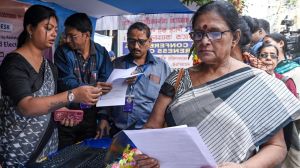Crowd behaviour will be in focus
Three times in the last six months I've witnessed the degrading sight of a magnificent cricketer virtually pleading with louts in the cro...

Three times in the last six months I’ve witnessed the degrading sight of a magnificent cricketer virtually pleading with louts in the crowd to behave reasonably. First it was Shane Warne at the MCG, then Sachin Tendulkar at Eden Gardens and finally Sir Garfield Sobers at Kensington Oval. The lunatics are running the asylum.
Crowd behaviour will be a major focus during the World Cup and already the Sussex club has banned alcohol at the Hove ground for the important India versus South Africa clash. There’s no doubt that security will be extremely tight, following the horrific bomb blasts in and around London in the last few weeks. Incidentally, in order to be consistent, it would be reasonable to expect that Australia and the West Indies, who both refused to play in Colombo in the last World Cup, will abstain from competing in games in London this time. I await with interest the reaction if either side is allocated a London game in the Super Six stage.
Cricket crowds have never been a major problem in theUK, where the soccer hooligans have captured all the attention. One of the best atmospheres I’ve witnessed at a cricket ground was at Edgbaston for the first Ashes Test in 1997, where sections of the crowd dressed up and enjoyed themselves in a carnival atmosphere. It ranked with grounds like Kensington Oval in Barbados where Mac Fingal and his band add greatly to the color, the St.John’s Recreation ground in Antigua where Chicky’s disco belts out the music and Gravy provides the live theatre which has the crowd in hysterics and Premadasa stadium in Colombo where the band plays non-stop and the energetic fans dance in rhythm. These are all wonderful diversions for the crowd and it helps to keep their mind off other matters when the cricket is a little slow.
Administrators may have to seriously think about diversions like these, as seven hours is a long time to sit at a cricket ground and there are always going to be slow periods. In the USA, the fans at major sporting events are constantly entertained viathe large video screen and you rarely, if ever hear of trouble. At Edgbaston a jazz band wander through the car park prior to the commencement of play and fans arrive at their seat in a jovial mood after a burst of toe-tapping music. This could well be taking a leaf out of the songbook and "putting’ trouble on the run."
When I attended a few English soccer games in the seventies I felt the administrators were inviting trouble by not providing any entertainment before kick-off. The pubs closed about half an hour before kick off and it was straight from the bar to the terraces – a recipe for disaster. At the Wembley Cup final in 1989, with both the Heysel stadium disaster in Belgium and the Hillsborough (England) tragedy still fresh in the mind, it appeared the officials had learnt nothing about crowd control. There were thousands gathered outside the stadium without tickets and if it wasn’t for the fact that there is plenty of space outside Wembley for milling crowds, this would’ve been another disasterwaiting to happen.
Therein lie a couple of the problems for officials in England. The grounds are generally small and are often in suburban streets and if it’s an important game (like India versus South Africa at Hove), the ground capacity will be sorely tested. The culture in England needs to be changed and fans educated so that they realise if they haven’t booked a ticket, there is no point in going to the ground. A good starting point would be to eradicate the practice of scalping and convince a lot of One Day cricket attendees, that the day out isn’t a minor variation on the theme "let’s go down the pub and get pissed." While they’re at it, administrators could include tips in their publications on how to actually watch a game of cricket. That way fans might come away from the ground fulfilled, rather than just being "full" and then we might be spared the embarrassing sight of star players begging hooligans to behave.
- 01
- 02
- 03
- 04
- 05































